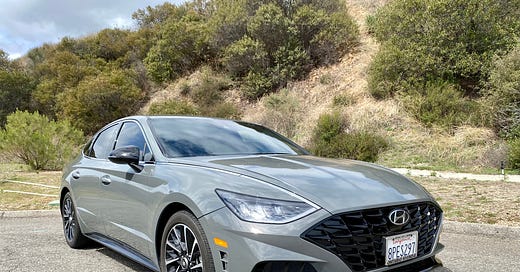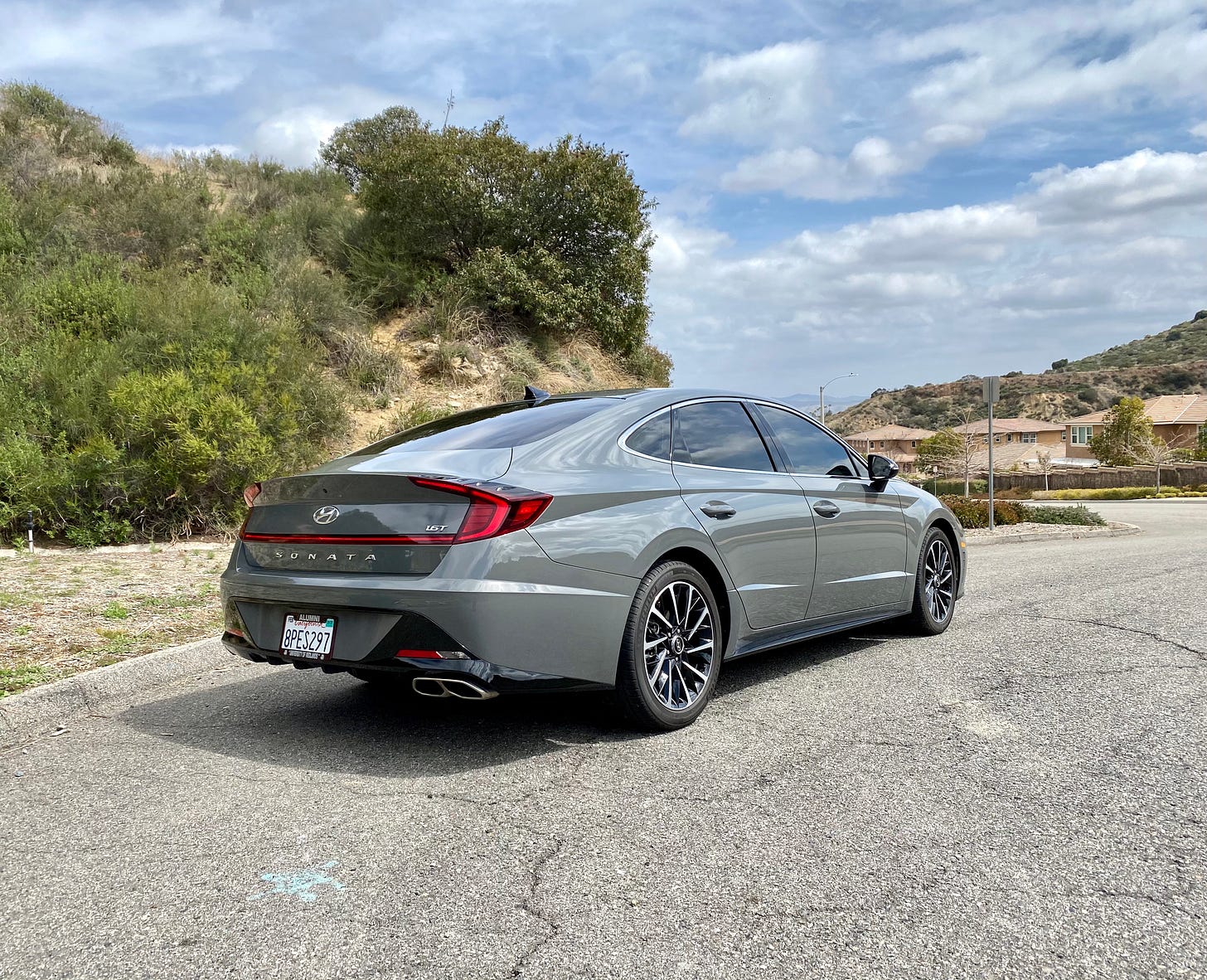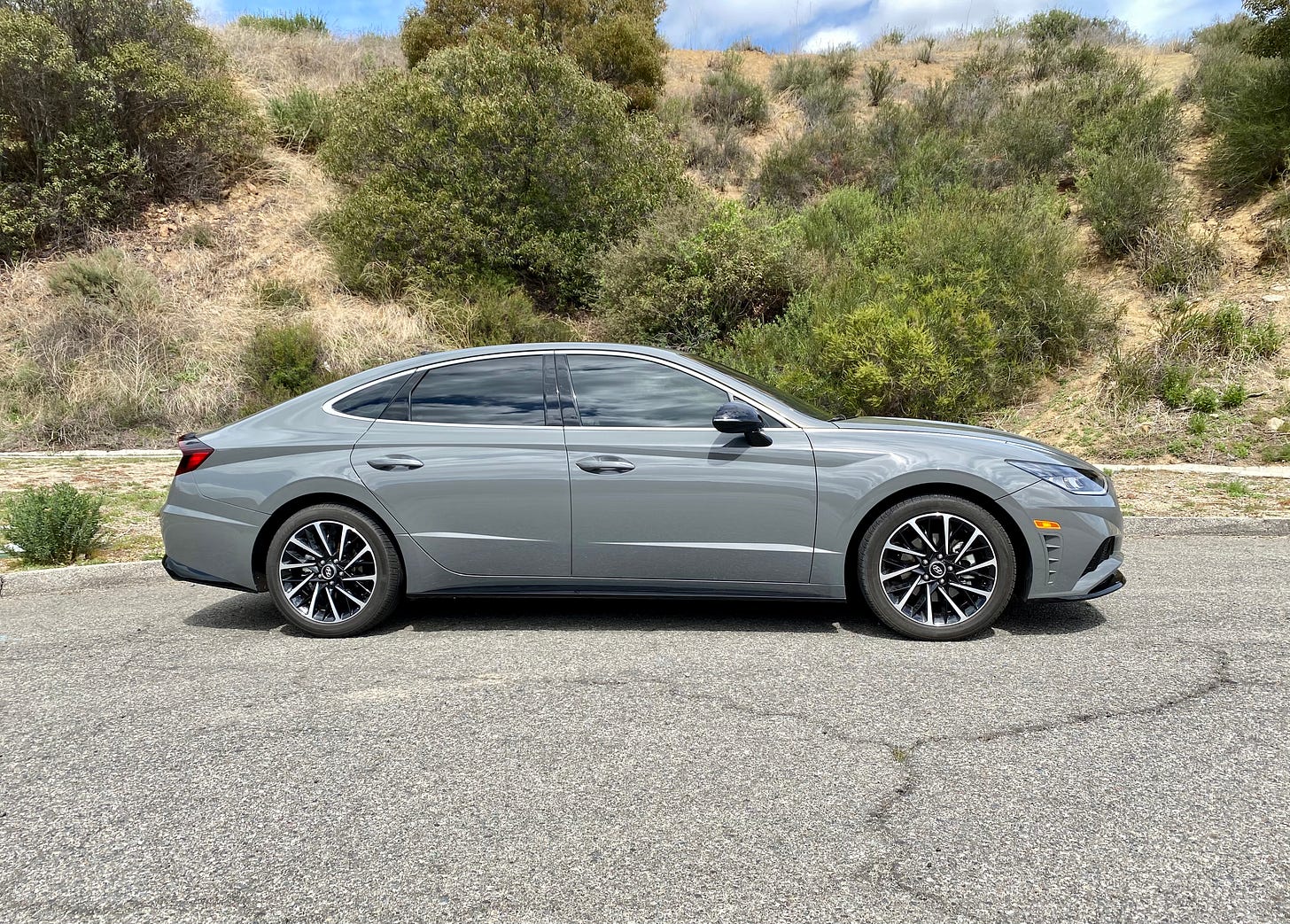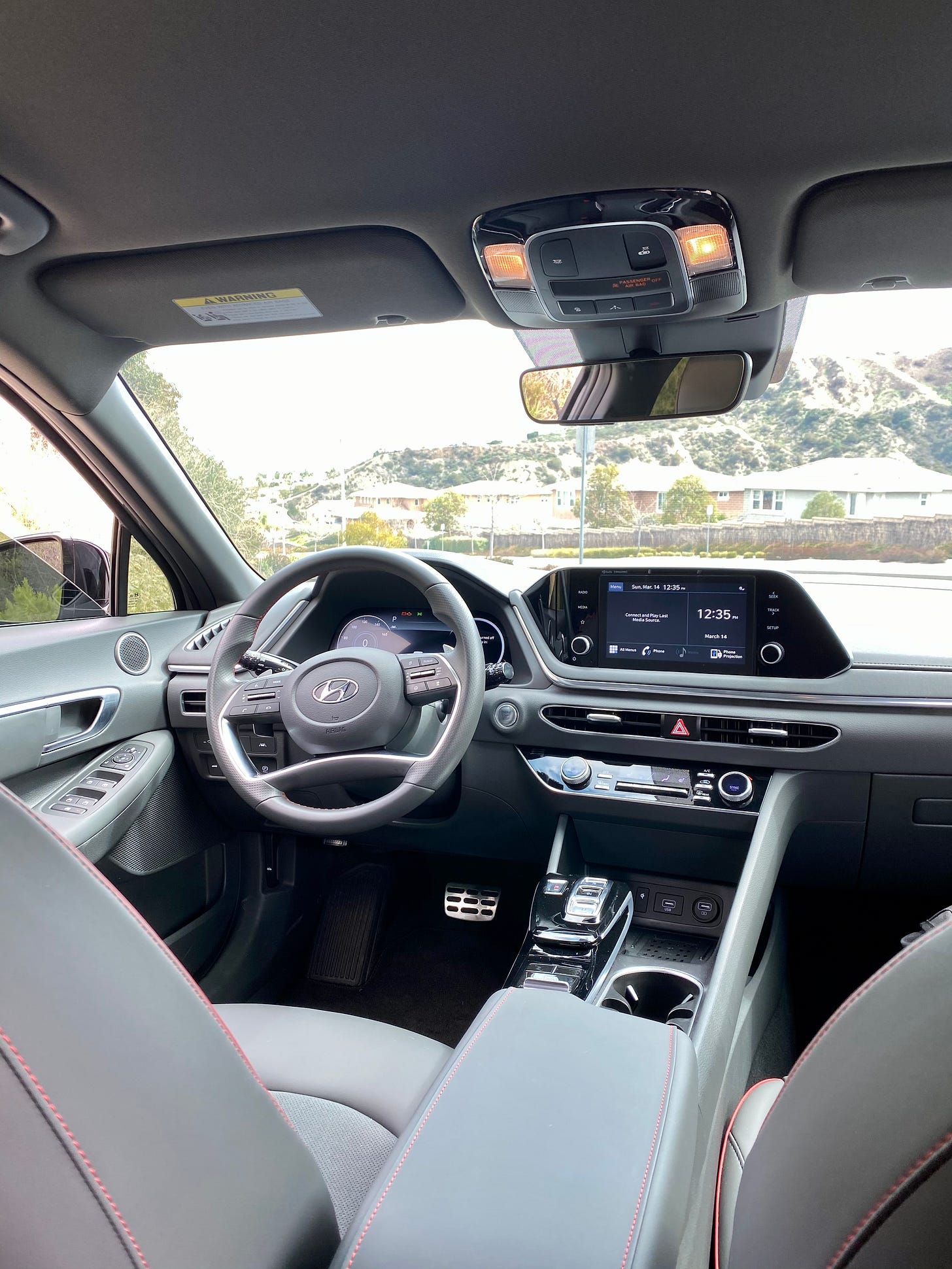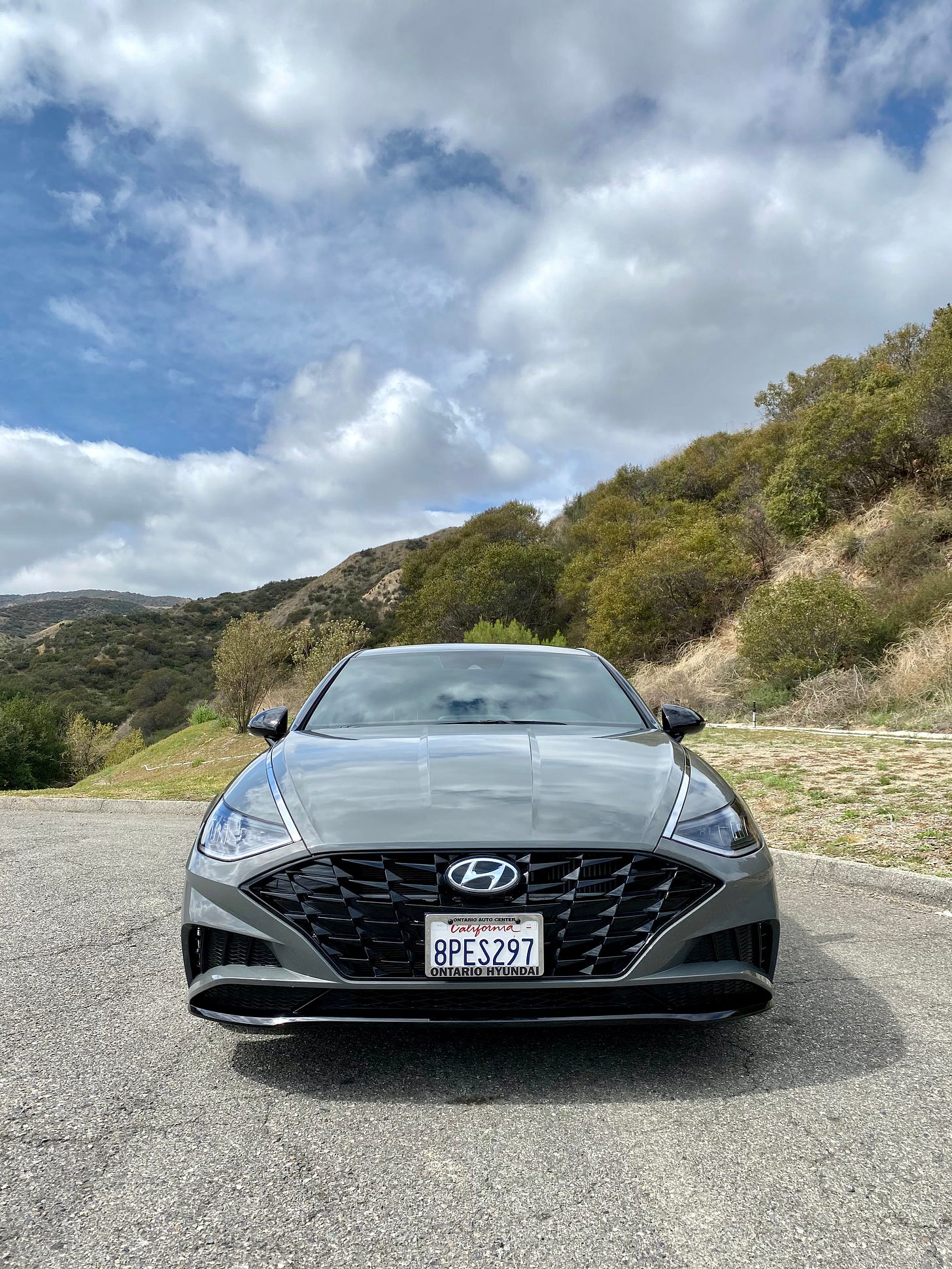2020 Hyundai Sonata: Boring Gay Car Review
Luxury feel, striking looks, and impressive tech - but is that enough to convince label-oriented shoppers to go for a Sonata?
Ever since the new Hyundai Sonata (and corporate cousin Kia K5) were released, I have been itching to get my hands on one. It seems to be rarer that cars see a revolutionary redesign between generations, but wow, Hyundai completely leveled up here. I was able to check out a 2020 Sonata SEL, which is one trim above the base model (SE) and very well equipped between standard features and options.
But before I get into the car, some of you might be thinking - Lex, I am a young and snatched queer person living my life out loud. I am a vision, vibe, and brand. When I think of myself in a new car, I don’t think of a Sonata. I hear you guys. The Sonata - to date - has been more closely associated with a reliable, middle-of-the-road family sedan than a statement vehicle. But for those of you who see yourself in an entry-level luxury vehicle, perhaps from Lexus, Mercedes, BMW, or Audi, I’d urge you to take a look at the all-new Sonata. No car on the road looks anything like this, so this is not the Sonata of the past. Especially with the right options and colors (such as gray and black combo on my test car), this thing looks aggressive, sporty, and sharp. I’d argue that the expected car for a young professional might be a BMW 3-Series or Lexus IS (which both have their merits), but this new Sonata is a great way to achieve that feel and style at significant cost savings.
So let’s get into it. The lower, meaner, and wider Sonata was completely redesigned for 2020. Most notable on the design is the coupe-like shape (see: Audi A7, Mercedes CLS) and the LED running lights that blend into the hood - something completely new that I haven't seen on any car before this. The Sonata starts at shy of $24K and can get as high as $34K for a fully loaded Limited trim (which really has some cutting-edge tech). My SEL in the review runs about $25,800, and is a nice balance of options. The Sonata gets 27 City / 37 Highway MPG via a 191-horsepower 2.5L 4-cylinder engine paired with an 8-speed automatic transmission. That’s good for a smooth ride and a 7.9 second 0-60 time (not a racecar, but an adequate amount of power for most drivers). There is also a separate hybrid model starting around $27,750 that gets a combined 53 MPG. Competitors for the Sonata are well-known, including its own cousin the Kia K5, as well as the Toyota Camry and Honda Accord. I will say it’s an exciting time for the segment. While many manufacturers are abandoning traditional sedans for SUVs, the others committed to sedans are creating some of the best products we’ve ever seen.
Key features in the base (SE) trim are quite impressive, and I’m a big fan of driver safety and self-driving features coming standard in most new cars these days. The base Sonata comes with forward-collision avoidance assist and pedestrian detection sensors. It also includes driver attention warnings (pay attention y’all) and the technology I was most impressed by - lane trace assist. That’s right, even the base Sonata will essentially steer itself on most gentle curves and it does so better than some of the more expensive systems I’ve tried. Paired with the also-standard smart cruise control capable of stop-and-go operation, this thing comes close to driving itself in traffic on a highway as long as your hands are on or near the wheel every so often…not bad for a car in the low $20’s. Of course, no car can actually drive itself legally yet, but the technology is still impressive. All Sonata’s also come standard with an 8-inch touch screen media display with Apple Carplay and Android Auto.
The SEL adds some very nice style flexes (black grille, trim, and upgraded rims), heated seats, blind-spot monitor and collision avoidance, and rear cross-traffic collision avoidance. If y’all crash in this Sonata it’s on you, because the car is giving everything it has to protect you. As you move up the trims (and price), the SEL Plus gets you a 12.3” digital instrument cluster, wireless device charging, 19” rims, and a digital key. The sports-oriented N-Line gets you an entirely different engine (290 horsepower turbo, sport seats, and design upgrades throughout. The N-Line would give most entry-level luxury cars a run for their money (beating most base engines from luxury manufacturers at a lower cost). The Limited adds even more luxury, with surround-view cameras and remote parking assist (aka you can move the car out of a parking spot without even being in it - just like a Tesla).
Overall, I was impressed by the quality of materials on the Sonata, particularly on the outside. Every possible light is an LED - a standard benefit that would have cost you a pretty optional penny on any car a few years ago. I’d encourage you to spring for at least the SEL model, as the design upgrades make the car look a lot more upscale and sporty than the base model for a modest price increase. Inside, I was quite into the gray leatherette seating surfaces and red piping details. Certain things I was not a fan of - such as the black surround on the media screen (which would likely be remedied if you upgraded to a trim with a bigger screen). Too much shiny black gives the inside a cheaper feel. I’m also not the biggest fan of the steering wheel design, but that’s not the end of the world. My SEL had the optional digital gauge cluster which instantly makes the car feel very luxurious - another worthwhile option. While the car doesn’t necessarily feel like a Mercedes or Audi on the inside, the technology brings it pretty close (and, of course, it’s much cheaper). All Sonatas come with a 5 year/60,000-mile warranty (better than many competitors out there) and 3 years/36,000 of included maintenance (a nice touch)!
I seriously enjoyed this car and have thought about it often since my review. While a younger me may not have been sold on driving a Sonata, the current me who seeks a reliable, technologically advanced, and stylish car at a reasonable price is very intrigued. Three reasons to buy: (1) a fully-loaded Sonata is cheaper than a Camry or Accord - and of course, all luxury competitors; (2) very striking design - good to make a statement; and (3) all of the latest technology at a valuable price. Three reasons not to buy: (1) base engine is somewhat dull for those used to a sportier car; (2) some people say the suspension is a bit more comfortable than sporty (but hey, it’s not claiming to be a sports car and is still pretty fun to drive); and (3) getting a fully-loaded model (around $35K) might tempt some label-oriented shoppers to opt for the base model of a luxury brand instead of a Hyundai. But it’s really a lifestyle call on whether you’d rather have a luxury car with fewer options or a more “common car” with cooler options. Hopefully, you enjoyed this review - hit the heart icon below to let me know you did, and please head to my IG story highlights under “Car Reviews - Sedans” to see more on the Sonata.
-Lex

